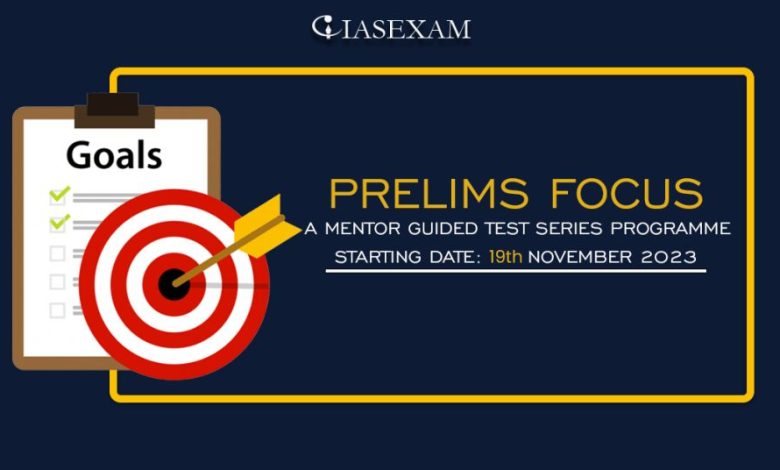Prelims Focus – 6th April 2024

ABHA
Recent News:
The Ayushman Bharat Health Accounts (ABHA) is an important part of India’s primary national health protection program, known as Ayushman Bharat Pradhan Mantri Jan Arogya Yojana (AB-PMJAY).
Details:
- Ayushman Bharat Health Account (ABHA) is a unique number that connects all of an individual’s health records.
- Anyone can sign up for the Ayushman Bharat Digital Mission (ABDM) to receive a free Health ID or ABHA.
- ABHA users have a 14-digit number as their health identifier, an easy-to-remember username called ABHA address, and a mobile app to access their health records and share them with healthcare providers.
- The ABDM program offers features such as cashless transactions, electronic health records, portability across various healthcare providers, real-time monitoring of fund utilisation, and promoting transparency and accountability.
National Medical Commission
Recent News:
The Supreme Court has instructed the National Medical Commission to provide information on the stipend situation in medical colleges in all States.
Details:
- The National Medical Commission Act, 2019, which became effective on September 25, 2020, established the National Medical Commission (NMC) to replace the Medical Council of India.
- The NMC is responsible for regulating medical education and professionals in India, including granting recognition of medical qualifications, accrediting medical schools, registering medical practitioners, monitoring medical practice, and assessing medical infrastructure.
- Headquartered in New Delhi, the NMC’s functions include setting policies to maintain high standards in medical education, regulating medical institutions and professionals, assessing healthcare needs and infrastructure, ensuring State Medical Councils comply with guidelines, providing appellate jurisdiction over Autonomous Boards’ decisions, promoting ethical conduct in the medical profession, and setting guidelines for fees in private medical institutions and universities.
Project Akashdeep
In News: The Indian Army has started the induction of Akashteer Command and Control Systems under ‘Project Akashdeep’ to bolster its air defence capabilities.
-
- It is developed through Bharat Electronics Limited (BEL) as part of the Atma Nirbhar Bharat initiative.
- It is a latest initiative designed to automate air defence control and reporting approaches by digitising the whole system.
- The system’s Control Centres, designed to be automobile-based and cell, can maintain operational abilities even in tough communique environments.
- It aims to permit tracking of low-level airspace over the conflict regions of the Indian Army and efficiently control the Ground Based Air Defence Weapon Systems.
- By integrating radar and communication systems at all levels into a unified network, Akashteer aims to deliver an unprecedented level of situational awareness and control.
- Project Akashdeep
-
- It is an automated air defence control and reporting system, just like the Indian Air Force’s system.
- It focuses on building a comprehensive air defence picture for monitoring, tracking, and engaging air defence assets by digitising the entire process.
Agni-Prime Ballistic Missile
In News: Recently, the new generation ballistic missile Agni-Prime was successfully flight-tested by the Strategic Forces Command (SFC).
- It is a two-stage, surface-to-surface, canister-launched, avenue-cellular, and strong-fueled medium-variety ballistic missile.
- The Agni-Prime is equipped with a twin redundant navigation and guidance system.
- It has a selection between 1000 to 2000 km.
- The missile is lighter than all the earlier Agni collection of missiles.
- It features significant upgrades to the composite motor casing, a manoeuvrable reentry vehicle (MaRV), along with improved propellants, navigation, and guidance systems.
Disaster Relief Funds
In News: Tamil Nadu has filed a suit at the Supreme Court claiming that the Centre is withholding national disaster relief funds, after Cyclone Michaung and consequent floods rocked the state in 2023.
- Funds for catastrophe comfort are available to states from two sources — the State Disaster Relief Fund (SDRF) and the National Disaster Relief Fund (NDRF).
- These funds had been created with the enactment of the Disaster Management Act, 2005 (DMA), following the devastating tsunami in 2004.
- Calamities Under NDRF: It covers calamities which includes cyclones, droughts and floods that are considered to be of intense nature by means of the Government of India, and which require extra investment beyond what’s to be had in the SDRF.
- Process of Funding: A country that does not have adequate funds in the SDRF and has confronted a national calamity beyond the coping capacity of the State Government can submit a request for funds from the NDRF.
- First, the MHA will immediately represent an Inter Ministerial Central Team (IMCT) to visit the regions stricken by the calamity, and decide if there may be a need for added funds.
- Then, the IMCT will put up its recommendation to a sub-committee of the National Executive Committee on the way to determine how much funding may be made available.
- Finally, a committee chaired by way of the Home Minister, and comprising the Ministers for Agriculture and Finance, in addition to the NITI Aayog vice-chairman, will sign off on the release of NDRF funds.





.png)
